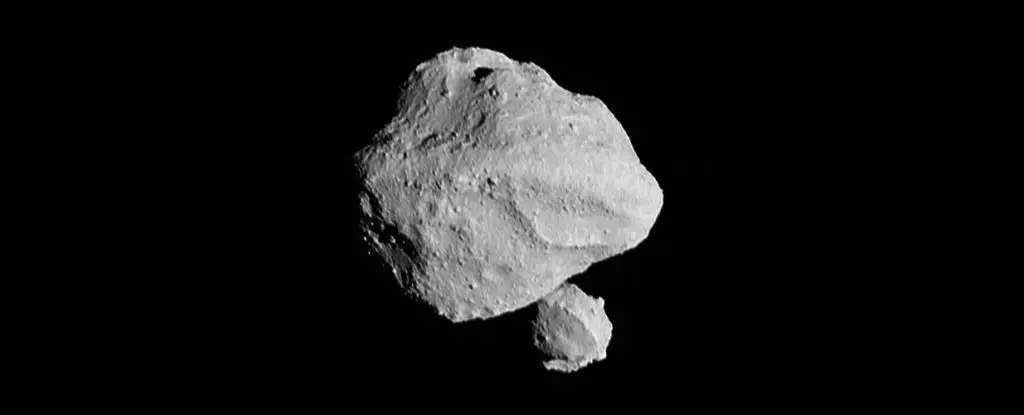

In a groundbreaking development, NASA’s asteroid probe Lucy has made an astonishing discovery during the first of its flybys of asteroid targets. The primary target, asteroid Dinkinesh, located in the main belt between Mars and Jupiter, has been found to have its own moonlet in a remarkably close orbit. This unexpected finding has profound implications for our understanding of the formation and interaction of rocks within the Solar System. Planetary scientist Simone Marchi of the Southwest Research Institute (SwRI) expresses the excitement, stating, “We have seen many asteroids up close, and one may think little is left to discover and surprise us. Well, that is clearly wrong. Dinkinesh, and its enigmatic moonlet, differ in some interesting ways from the similarly sized near-Earth asteroids that have been seen by spacecraft like OSIRIS-REx and DART.”
While we are aware of the existence of binary, trinary, and even quaternary asteroids within the Solar System, the exact abundance of such binary systems remains uncertain. It has long been observed that asteroids tend to cluster together, such as in the main belt and the Trojan swarms that share Jupiter’s orbit. However, the frequency at which asteroids come into close proximity with each other to become gravitationally bound remains elusive. The discovery of the moonlet orbiting Dinkinesh sheds new light on this phenomenon and suggests the possible existence of numerous binary asteroids yet to be documented. Understanding the prevalence of binary asteroids is crucial for unraveling the growth and dynamics of rocky bodies within the Solar System.
Scientists had a hunch that Dinkinesh might harbor a moonlet as the Lucy spacecraft approached the asteroid. The changing brightness of the object hinted at the presence of a secondary object orbiting Dinkinesh. The variations in brightness indicate that the moonlet intermittently comes in and out of view, affecting the overall light reflected by the asteroid. As Lucy approached closer, these suspicions were confirmed. The spacecraft, traveling at a staggering speed of 16,100 kilometers (10,000 miles) per hour, was able to capture detailed images of the two objects engaged in a captivating orbital dance. The larger rock, according to preliminary measurements, spans approximately 790 meters (2,600 feet) at its widest point, while the smaller moonlet measures a relatively diminutive 220 meters (720 feet).
Asteroids, particularly those occupying Jovian orbits, are believed to retain the pristine materials that formed the planets during the early stages of the Solar System. Lucy’s mission aims to study these asteroids to gain insights into the formation of the Solar System and the processes behind planet formation. By investigating more binary asteroids like Dinkinesh, scientists hope to enhance our understanding of how rocks accumulated and merged to give rise to larger celestial bodies. This knowledge is especially pertinent as it pertains to the formation of terrestrial planets in the inner Solar System.
While the discovery of the binary nature of Dinkinesh has already revolutionized our understanding, there is still much more to learn from the data collected by Lucy. Extracting and analyzing the remaining information from the encounter with Dinkinesh will not only uncover more about the asteroid but also provide valuable insights into the functioning and capabilities of the Lucy spacecraft itself. The mission continues with Lucy embarking on its journey towards its second encounter with a main belt asteroid called Donaldjohanson, scheduled to occur in 2025.
The startling revelation of a moonlet orbiting the asteroid Dinkinesh has opened up new avenues of exploration and scientific inquiry. This unexpected finding challenges our preconceptions and invites us to reevaluate our understanding of the Solar System’s dynamics. As Lucy continues its mission, venturing deeper into the cosmos, we eagerly anticipate the wealth of knowledge it will unveil, propelling us closer to comprehending the mysteries that lie within our celestial neighborhood.
A groundbreaking expedition led by an international research team, featuring esteemed scientists from the University…
The pursuit of coherent control over wave transport and localization stands as a monumental challenge…
In recent astronomical explorations, researchers have unearthed a striking phenomenon emanating from a distant corner…
The quest for sustainable practices within the chemical industry is more critical than ever. Researchers…
In the complex interplay of human health, the relationship between the gut and the brain…
The relentless drive for sustainable energy solutions has fueled remarkable advancements in solar technology, with…
This website uses cookies.